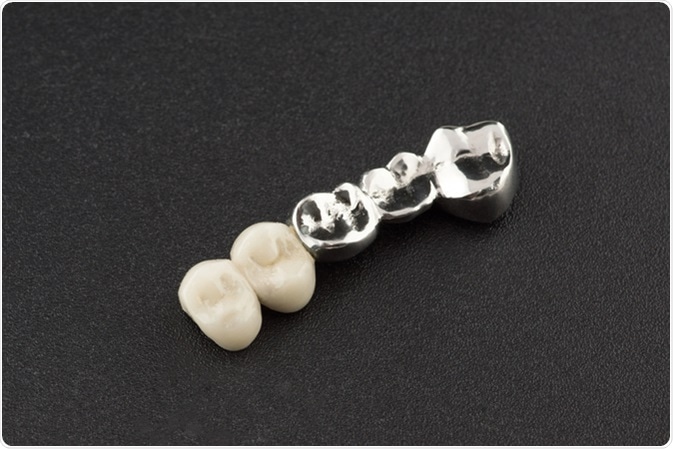The primary purpose of a dental bridge is to fill a gap in the dental arch caused by a missing tooth or teeth. This can help to improve the appearance and function of the mouth so that patients are able to eat and speak in a way similar to before the teeth were missing.

Image Credit: Krezodent / Shutterstock
Indications
A dental bridge may be used to replace the loss of:
- One to four incisors
- A canine
- One or more molars
- Two premolars and the first molar
Partial edentulism is the term used for the condition when one or more teeth are missing from the dental arch, but there are healthy teeth that remain on the arch that are able to support the bridge. This is the most common indication for a dental bridge, known as a partial edentulism restoration. If there are no healthy teeth in the dental arch available to support a bridge, dental implants may be placed to support restoration with a dental bridge.
A dental bridge may sometimes be used when there are signs of large cavities or erosions in the teeth. The severely damaged teeth may be removed before the dental bridge is placed to replace them. This should only be carried out if the natural teeth are so badly damaged that they are not salvageable.
Aesthetic reasons
One of the main purposes that a dental bridge is offered to patients is to restore the appearance of their smile and maintain the shape of their face. Teeth play an important role in the overall look of a person, and having a full smile without noticeably missing teeth can make a significant difference in improving the confidence of a person.
Additionally, the placement of a dental bridge can help to prevent the remaining teeth from moving out of the correct position, which can alter the shape of their jaw and face.
A dental bridge can also be placed for aesthetic reasons to replace one or many teeth that have significant defects such as discoloration, unsightly fillings or an abnormal shape.
Dental bridges explained (False teeth alternative)
Functional reasons
Dental bridges also help to improve the function of the mouth. People who have a missing or weak tooth often find it difficult to chew or speak normally. Therefore, filling the gap with a dental bridge can be useful to restore an individual’s chewing and speaking abilities.
Additionally, a dental bridge can assist in properly distributing forces in bite. This is important to maintain the strength in the other healthy teeth and prevent further problems in the future.
Contraindications
There are some situations when a dental bridge is not likely to be the best solution and may be contraindicated.
For example, if there are insufficient healthy abutment teeth on the dental arch to support the bridge, the bridge will not be well stabilized and may cause more damage to the mouth. Instead, alternative restoration methods such as removable dentures or dental implants may be better suited to the situation.
Dental bridges are a poor solution for patients who continue to practice insufficient oral hygiene procedures. It is important for patients to maintain good oral hygiene standards to take care of the bridge and increase the durability of the restoration. Patients should be encouraged to improve their oral hygiene practices before undergoing restoration with a dental bridge.
Other reasons that a dental bridge may be contraindicated include:
- Excessive bone loss
- Large pulp chambers in young patients
- Elderly patients
References
Further Reading
Last Updated: Mar 13, 2023